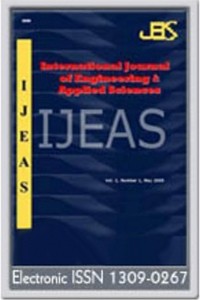OPTIMUM CONFIGURATION OF FUEL CELL-B PV/WIND HYBRID SYSTEM USING A HYBRID METAHEURISTIC TECHNIQUE
Because of their low impact on environment, PV/wind hybrid systems which use fuel cells (FCs) as the energy storage device are one of the most promising renewable energy sources. In such systems, optimum configuration (sizing) plays an important role for decreasing the system cost. In this paper, PV/wind/FC system is modeled and a hybrid metaheuristic technique based on chaotic search (CS), harmony search (HS) and simulated annealing (SA) is employed to find the optimum configuration. Optimum configuration is found for PV/FC, wind/FC, and PV/wind/FC systems and the results are compared.
Keywords:
Hybrid systems PV/wind/fuel cell, Optimum configuration,
___
- [1] D. Nelson, M. Nehrir, and C. Wang, "Unit sizing and cost analysis of stand-alone hybrid wind/PV/fuel cell power generation systems," Renewable energy, vol. 31, pp. 1641-1656, 2006.
- [2] M. Calderón, A. Calderón, A. Ramiro, and J. González, "Automatic management of energy flows of a stand-alone renewable energy supply with hydrogen support," International Journal of Hydrogen Energy, vol. 35, pp. 2226-2235, 2010.
- [3] R. Valdés, L. Rodríguez, and J. Lucio, "Procedure for optimal design of hydrogen production plants with reserve storage and a stand-alone photovoltaic power system," International Journal of Hydrogen Energy, vol. 37, pp. 4018-4025, 2012.
- [4] M. H. Nehrir and C. Wang, Modeling and control of fuel cells: distributed generation applications vol. 41: John Wiley & Sons, 2009.
- [5] N. A. Ahmed, M. Miyatake, and A. Al-Othman, "Power fluctuations suppression of stand-alone hybrid generation combining solar photovoltaic/wind turbine and fuel cell systems," Energy Conversion and Management, vol. 49, pp. 2711-2719, 2008.
- [6] M. Uzunoglu, O. Onar, and M. Alam, "Modeling, control and simulation of a PV/FC/UC based hybrid power generation system for stand-alone applications," Renewable Energy, vol. 34, pp. 509-520, 2009.
- [7] P. Zervas, H. Sarimveis, J. Palyvos, and N. Markatos, "Model-based optimal control of a hybrid power generation system consisting of photovoltaic arrays and fuel cells," Journal of power sources, vol. 181, pp. 327-338, 2008.
- [8] D. Rekioua, S. Bensmail, and N. Bettar, "Development of hybrid photovoltaic-fuel cell system for stand-alone application," International Journal of Hydrogen Energy, 2013.
- [9] J. Lagorse, M. G. Simoes, A. Miraoui, and P. Costerg, "Energy cost analysis of a solar-hydrogen hybrid energy system for stand-alone applications," International journal of hydrogen energy, vol. 33, pp. 2871-2879, 2008.
- [10] S. Diaf, D. Diaf, M. Belhamel, M. Haddadi, and A. Louche, "A methodology for optimal sizing of autonomous hybrid PV/wind system," Energy Policy, vol. 35, pp. 5708-5718, 2007.
- [11] E. Koutroulis, D. Kolokotsa, A. Potirakis, and K. Kalaitzakis, "Methodology for optimal sizing of stand-alone photovoltaic/wind-generator systems using genetic algorithms," Solar energy, vol. 80, pp. 1072-1088, 2006.
- [12] B. Zhang, Y. Yang, and L. Gan, "Dynamic control of wind/photovoltaic hybrid power systems based on an advanced particle swarm optimization," in Industrial Technology, 2008. ICIT 2008. IEEE International Conference on, 2008, pp. 1-6.
- [13] A. Askarzadeh, "A discrete chaotic harmony search-based simulated annealing algorithm for optimum design of PV/wind hybrid system," Solar Energy, vol. 97, pp. 93-101, 2013.
- [14] A. Askarzadeh and A. Rezazadeh, "A grouping-based global harmony search algorithm for modeling of proton exchange membrane fuel cell," International Journal of Hydrogen Energy, vol. 36, pp. 5047-5053, 2011.
- [15] A. Askarzadeh and A. Rezazadeh, "Parameter identification for solar cell models using harmony search-based algorithms," Solar Energy, vol. 86, pp. 3241-3249, 2012.
- [16] A. Askarzadeh, "Developing a discrete harmony search algorithm for size optimization of wind–photovoltaic hybrid energy system," Solar Energy, vol. 98, pp. 190-195, 2013
- Başlangıç: 2009
- Yayıncı: Akdeniz Üniversitesi
Sayıdaki Diğer Makaleler
Jagannathan SRAVANAN, Kannan SUGUNA, Pulipaka Narasimha Rao RAGHUNATH
